Baja California
Baja California | ||
|---|---|---|
State | ||
| Free and Sovereign State of Baja California Estado Libre y Soberano de Baja California (Spanish) | ||
|
Deputies | ||
| Area Area code | ||
Ranked 2nd | ||
| Website | Official website | |
| ^ a. 2010 and later. Baja California is the only state to use the U.S. DST schedule state-wide, while the rest of Mexico (except for small portions of other northern states) observes standard time year-round.[6]
United States dollars, with US$1 valued at 12.80 pesos (value of 3 June 2010).[8] | ||
Baja California
The state has an estimated population of 3,769,020 as of 2020,
Baja California is the 12th-largest state by area in Mexico. Its geography ranges from beaches to forests and deserts. The backbone of the state is the Sierra de Baja California, where
History
Prehistory and Spanish colonial era
The first people came to the peninsula at least 11,000 years ago. At that time, two main native groups are thought to have been present on the peninsula – the
Another group of people was the Guachimis, who came from the north and created much of the
Europeans reached the present state of Baja California in 1539, when Francisco de Ulloa reconnoitered its east coast on the Gulf of California and explored the peninsula's west coast at least as far north as Cedros Island. Hernando de Alarcón returned to the east coast and ascended the lower Colorado River in 1540, and Juan Rodríguez Cabrillo (or João Rodrigues Cabrilho (in Portuguese)) completed the reconnaissance of the west coast in 1542. Sebastián Vizcaíno again surveyed the west coast in 1602, but outside visitors during the following century were few.
The
After the
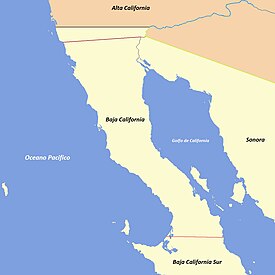
The
In 1804, the Spanish crown divided California into
Post-independence, 1821–present
Early republic
Era of Porfirio Díaz
When liberal army general Porfirio Díaz came to power in 1876, he embarked on a major program to develop and modernize Mexico.
- 1884: Luis Huller and George H. Sisson obtain a concession covering much of the present state in return for promises to develop the area.[15]
- 1905: The anarchist movement based on the writings of Ricardo Flores Magón and Enrique Flores Magón, begins.
- 1911: Mexicali and Tijuana are captured by the Mexican Liberal Party (Partido Liberal Mexicano, PLM), but soon surrender to Federal forces.
Postrevolutionary Mexico
- 1917: On 11 December, "[a] prominent Mexican, close friend of President U.S. Senator Henry Ashurst to sell Baja California to the U.S. for "fifty million dollars gold".[16]
- 1931: Baja California is further divided into Northern and Southern territories.
- 1952: The North Territory of Baja California becomes the 29th state of Mexico, Baja California. The southern portion (below 28°N) remains a federally administered territory.
- 1974: The South Territory of Baja California becomes the 31st state, Baja California Sur.
- 1989: Ernesto Ruffo Appel of the National Action Party (PAN) becomes the first non-Institutional Revolutionary Party governor of Baja California and the first opposition governor of any state since the Revolution.
Geography
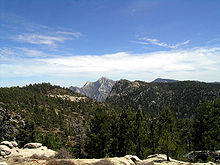
Baja California encompasses a territory within
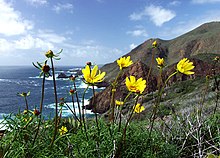
Temperate winds from the Pacific Ocean and the cold
To the east, the Sonoran Desert enters the state from both California and Sonora. Some of the highest temperatures in Mexico are recorded in or nearby the Mexicali Valley.
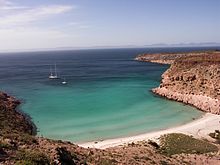
There are numerous islands on the Pacific shore. Guadalupe Island is located in the extreme west of the state's boundaries and is the site of large colonies of sea lions. Cedros Island exists in the southwest of the state's maritime region. The Todos Santos islands and Coronado Islands are located off the coasts of Ensenada and Tijuana, respectively. All of the islands in the Gulf of California on the Baja California side belong to the municipality of Mexicali.
Baja California obtains much of its water from the Colorado River. Historically, the river drained into the
Climate
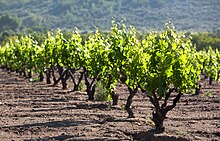
Baja California's climate varies from

The change of altitude towards the Sierra de Baja California creates an
The east side of the mountains produces a rain shadow, creating an extremely arid environment. The Sonoran Desert region of Baja California experiences hot summers and nearly frostless mild winters. The Mexicali Valley (which is below sea level) experiences the highest temperatures in Mexico, frequently surpassing 47 °C (116.6 °F) in mid-summer, and exceeding 50 °C (122 °F) on some occasions.
Further south along the Pacific coast, the Mediterranean climate transitions into a desert climate, but it is milder and not as hot as along the gulf coast. Transition climates, from Mediterranean to desert, can be found from San Quintín to
Flora and fauna
Common trees are the
In the main wildlife refuges on the peninsula of Baja California,
The fauna in the parks include a large number of mammals, primarily
| Flora and fauna of Baja California | |||||||

|

|

|

|

| |||
| Sea otter | Cougar | California quail | Vaquita | California condor | |||
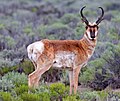
|

|

|

|

| |||
| Pronghorn | Great white shark | Guadalupe fur seal | Crotalus cerastes | Bighorn sheep | |||

|

|

|

|

| |||
Fouquieria columnaris
|
Eschscholzia californica | Washingtonia filifera | Coreopsis gigantea | Pinus radiata | |||
2010 earthquakes
At 3:40:41 pm PDT on Easter Sunday, 4 April 2010, a 7.2 Mw (on the
Government

Municipalities of Baja California
Baja California is subdivided into seven
Politics
State elections

In Baja California, state elections are held every two years (every three years prior to 2019) for the positions of state governor, 25 state deputies of the Congress of Baja California, and 5 municipal mayors. Of the 25 state deputies, 17 are elected by relative majority in each of the electoral districts, while another 8 are elected by proportional representation. The 17 deputies elected by relative majority may be re-elected for up to four consecutive terms, while the other 8 deputies can only serve one term.
During the 2019 Baja California state election, Jaime Bonilla Valdez of the Morena-led Juntos Hacemos Historia coalition won by a margin of 27.58% to become the governor of Baja California. In addition, 21 out of 25 state deputy positions and all 5 municipal mayoral positions were won by candidates aligned with the Juntos Hacemos Historia coalition.
During the 2021 Baja California state election, Marina del Pilar Ávila Olmeda of the Morena-led Juntos Hacemos Historia coalition won by a margin of 17.49% to become the first female governor of Baja California. Of the state's 25 local deputies, 13 were won by Morena-aligned candidates, followed in a distant second place by candidates of the Solidarity Encounter Party (PES), National Action Party (PAN), and Labor Party (PT) with 3 seats each. All 5 municipal mayoral positions were again won by Morena-aligned candidates.
The next state elections are scheduled for 2023.
Federal elections
| Year | PRI | PAN | PRD | MORENA |
|---|---|---|---|---|
| 2018 | 8.86% 94,296
|
19.33% 205,747
|
63.10% 671,599
| |
| 2012 | 36.99% 446,192
|
27.20% 328,116
|
31.15% 375,803
|
|
| 2006 | 21.38% 203,233
|
47.35% 450,186
|
23.59% 224,275
|
|
| 2000 | 37.04% 319,477
|
49.76% 429,194
|
8.97% 77,340
|
|
| 1994 | 48.92% 402,332
|
36.18% 297,565
|
8.35% 68,669
|
During the 2018 Mexican general election, the presidential vote of Baja California was won by a landslide of almost 44% by Andrés Manuel López Obrador of the Morena party. Out of the 8 federal deputies representing Baja California in the Mexican Chamber of Deputies, 5 were won by Morena candidates, 2 were won by Social Encounter Party candidates, and 1 was won by a Labor Party candidate. The next Mexican general election is scheduled for 2024.
During the 2021 Mexican legislative election, six of the eight federal deputies representing Baja California in the Mexican Chamber of Deputies were won by Morena candidates, with the other two being won by candidates of the Labor and Ecologist Green parties. The next legislative elections are scheduled for 2024.
Demographics
This section needs additional citations for verification. (July 2022) |
Rank
|
Name
|
Municipality | Pop.
|
||||||
|---|---|---|---|---|---|---|---|---|---|
 Tijuana  Mexicali |
1 | Tijuana | Tijuana | 1,810,645 |  Ensenada  Rosarito | ||||
| 2 | Mexicali | Mexicali | 854,186 | ||||||
| 3 | Ensenada | Ensenada | 330,652 | ||||||
| 4 | Rosarito | Playas de Rosarito | 100,660 | ||||||
| 5 | Tecate | Tecate | 81,059 | ||||||
| 6 | Villa del Campo | Tijuana | 33,360 | ||||||
| 7 | Maneadero | Ensenada | 27,969 | ||||||
| 8 | Guadalupe Victoria | Mexicali | 19,081 | ||||||
| 9 | Lázaro Cárdenas | San Quintín | 18,829 | ||||||
| 10 | San Felipe | San Felipe | 17,143 | ||||||
| Year | Pop. | ±% |
|---|---|---|
| 1895 | 42,875 | — |
| 1900 | 7,583 | −82.3% |
| 1910 | 9,760 | +28.7% |
| 1921 | 23,537 | +141.2% |
| 1930 | 48,327 | +105.3% |
| 1940 | 78,907 | +63.3% |
| 1950 | 226,965 | +187.6% |
| 1960 | 520,165 | +129.2% |
| 1970 | 870,421 | +67.3% |
| 1980 | 1,177,886 | +35.3% |
| 1990 | 1,660,855 | +41.0% |
| 1995 | 2,112,140 | +27.2% |
| 2000 | 2,487,367 | +17.8% |
| 2005 | 2,844,469 | +14.4% |
| 2010 | 3,155,070 | +10.9% |
| 2015 | 3,315,766 | +5.1% |
| 2020 | 3,769,020 | +13.7% |
| 2015 data from Encuesta Intercensal 2015.[4] | ||

Although the state is more European in ancestry, it has historically seen sizable East and Southeast Asian immigrant population. Mexicali has a large Chinese community, as well as many
According to the 2020 Census, 1.71% of Baja California's population identified as Black,
Since 1960, large numbers of migrants from southern Mexican states have arrived to work in agriculture (especially the Mexicali Valley and nearby Imperial Valley, California, U.S.) and manufacturing. The cities of Ensenada, Tijuana, and Mexicali grew as a result of migrants, primarily those who sought U.S. citizenship. Those temporary residents awaiting their entry into the United States are called flotillas, which is derived from the Spanish word flota, meaning 'fleet'.[citation needed]
There is also a sizable immigrant community from Central and South America, and from the United States and Canada. An estimated 200,000+ American
Some 60,000 Oaxacans live in Baja California. Some 40% of them lack proper birth certificates.[29]
According to a
Education
Baja California offers one of the best educational programs in the country, with high rankings in schooling and achievement.
The state government provides education and qualification courses to increase the workforce standards, such as school–enterprise linkage programs which help the development of a labor force according to the needs of the industry.
91.60% of the population from six to fourteen years of age attend elementary school. 61.95% of the population over fifteen years of age attends or has already graduated from high school. Public school is available in all levels from kindergarten to university.
The state has 32 universities offering 103 professional degrees. These universities have 19 research and development centers for basic and applied investigation in advanced projects related to biotechnology, physics, oceanography, computer science, digital geothermal technology, astronomy, aerospace, electrical engineering and clean energy, among others. At this educational level, supply is steadily growing. Baja California has developed a need to be self-sufficient in matters of technological and scientific innovation and to be less dependent on foreign countries. Current businesses demand new production processes as well as technology for the incubation of companies. The number of graduate degrees offered, including PhD programs, is 121. The state has 53 graduate schools.[31]
Economy

As of 2005, Baja California's economy represents 3.3% of Mexico's gross domestic product, or US$21.996 billion.[33][full citation needed] Baja California's economy has a strong focus on tariff-free export oriented manufacturing (maquiladora). As of 2005, 284,255 people are employed in the manufacturing sector.[33] There are more than 900 companies operating under the federal Prosec program in Baja California.
Employment
In 2021, Baja California generated 57,550 new jobs, about 15.2 jobs per 1000 inhabitants, making it the 5th highest in the country and the second highest of any border state behind
As of November 2021, Baja California has the highest
Economic investment
As of September 2021, Baja California receives the third highest amount of foreign direct investment of any state in Mexico, constituting about 7.7% of the national total and behind only Nuevo León (7.7%) and Mexico City (16.5%). About 81.4% of Baja California's foreign domestic investment comes from the United States, of which 50.3% comes from the construction of natural gas pipelines and 8.2% comes car and truck manufacturing.[34]
Real estate
This section may contain material not related to the topic of the article. (September 2020) ) |
The Foreign Investment Law of 1973[35][36] allows foreigners to purchase land within the borders and coasts of Mexico by way of a trust handled through a Mexican bank (Fideicomiso). This trust assures to the buyer all the rights and privileges of ownership, and it can be sold, inherited, leased, or transferred at any time. Since 1994, the Foreign Investment Law stipulates that the Fideicomiso must be to a 50-year term[clarify], with the option to petition for a 50-year renewal at any time.[37]
Any Mexican citizen buying a bank trust property has the option to either remain within the trust or opt out of it and request the title in escritura.[further explanation needed]
Mexico's early history involved foreign invasions and the loss of vast amounts of land; in fear of history being repeated, the Mexican constitution established the concept of the "Restricted Zone".[38] In 1973, in order to bring in more foreign tourist investment, the Bank Trust of Fideicomiso was created, thus allowing non-Mexicans to own land without any constitutional amendment necessary.[39] Since the law went into effect, it has undergone many modifications in order to make purchasing land in Mexico a safer investment.
Highways
- Mexican Federal Highway 1
- Mexican Federal Highway 2
- Mexican Federal Highway 3
- Mexican Federal Highway 5
- Mexican Federal Highway 12
Media
Newspapers of Baja California include[40] El Centinela, El informador de Baja California, El Mexicano (edición Tijuana), El Mexicano Segunda Edición, El Sol de Tijuana, El Vigía, Esto de las Californias, Frontera, La Crónica de Baja California, La Voz de la Frontera, and Semanario Zeta.[41][42]
See also
- History of the west coast of North America
- Las Californias
- List of Baja California cities
- Spanish missions in present-day Baja California
Notes
- ^ This state is often informally referred to as Baja California Norte (literally "Lower California North" in English) or Baja Norte, to distinguish it from both the Baja California peninsula as a whole, of which it forms the northern half, and Baja California Sur, the adjacent state that covers the southern half of the peninsula. While Baja Norte and Baja California Norte are well-established terms for the northern half of the Baja California peninsula, they do not officially exist as political designations for any state or region. The latter name (Baja California Norte) was officially adopted from 1974 to 1979,[10] and endured unofficially thereafter.[11] In other words, "The northern state is officially known as Baja California, but since that name is easily confused with the name for the entire peninsula, it is commonly referred to by visitors and locals alike as Baja Norte."[12]
- ^ Delta in the northeast recorded 54.0 °C (129.2 °F) on 3 August 1998.
- SEMARNAT believes this to be the first viable plan presented.[citation needed]
References
- ^ a b "México en cifras". January 2016.
- ^ "Transformación Política de Territorio Norte de la Baja California a Estado 29" [Political Transformation of the North Territory of Peninsula de California to the 29th State] (in Spanish). Archived from the original on 14 September 2019. Retrieved 20 July 2008.
- ^ "Medio Físico del Estado de Baja California" [Landscape of the State of Baja California]. Enciclopedia de los Municipios de México (in Spanish). Archived from the original on 8 March 2012. Retrieved 12 February 2013.
- ^ INEGI. Archived from the original(PDF) on 10 December 2015. Retrieved 8 December 2015.
- ^ Citibanamex (13 June 2023). "Indicadores Regionales de Actividad Económica 2023" (PDF) (in Spanish). Retrieved 13 August 2023.
- ^ "Daylight Saving Time Around the World 2023". timeanddate.com. Archived from the original on 4 November 2022.
- INEGI. 2010. p. 40. Archived from the original(PDF) on 22 July 2011. Retrieved 1 October 2010.
- ^ "Reporte: Jueves 3 de Junio del 2010. Cierre del peso mexicano" [Report: Thursday, 3 June 2010. Close of the Mexican peso] (in Spanish). PesoMexicano. 3 June 2010. Archived from the original on 8 June 2010. Retrieved 10 August 2010.
- ^ Saldierna, J. F. Promexico. Editorial Emán. p. 68.
- ^ Lands and Peoples: North America (Volume 5 of Lands and Peoples, Grolier, 2005), p. 390.
- Times of San Diego(23 Apr 2021).
- ^ Jones, Fred and Jones, Gloria. Baja Camping: The Complete Guide, p. 6 (Avalon Travel Publishing, 1994).
- UNESCO World Heritage Convention. Archivedfrom the original on 28 June 2015. Retrieved 12 June 2015.
- ^ "History of Riverside County, California". Mocavo. Archived from the original on 16 March 2016.
- San Diego Historical Society. Archived from the originalon 20 August 2008. Retrieved 20 July 2008.
- The University of Arizona Press. p. 74.
- ^ "Normales Climatológicas 1971–2000". Servicio Meteorológico Nacional. 25 June 2007. Archived from the original (TXT) on 25 June 2007.
- .
- ^ Brandegee, Katharine Layne; Brandegee, Townshend Stith (1894). "Flora of the Cape Region". Zoe: A Biological Journal. 4 (4). Zoe Publishing Company – via Biodiversity Heritage Library.
- ^ Hogan, C. Michael (30 August 2008). Stromberg, Nicklas (ed.). "Western fence lizard (Sceloporus occidentalis)". Globaltwitcher. Archived from the original on 13 February 2012.
{{cite web}}: CS1 maint: unfit URL (link) - hdl:2246/1170.
- Earthquake Hazards Program. United States Geological Survey. 6 April 2010. Archived from the originalon 6 April 2010. Retrieved 17 March 2012.
- ^ Associated Press (4 April 2010). "At Least Two Die In 7.3-Magnitude Baja Quake". KTVU. KTVU. Archived from the original on 9 April 2010. Retrieved 17 March 2012.
- CNN Wire. Archivedfrom the original on 8 November 2012. Retrieved 17 March 2012.
- ^ "Resultados de las Elecciones Federales – México 2012" [Federal Election Results – Mexico 2012] (in Spanish). Archived from the original on 21 March 2013. Retrieved 22 February 2013.
- ^ "Censo Baja California 2020".
- INEGI. 2011. Archived from the originalon 9 March 2013. Retrieved 3 February 2013.
- ^ "Panorama".
- ^ López, Citlalli (28 November 2012). "Con problemas en acta de nacimiento 40% de oaxaqueños en Baja California" [40% of Oaxacans in Baja California have problems with birth certificates]. Noticiasnet (in Spanish). Archived from the original on 25 May 2014. Retrieved 24 May 2014.
- ^ Galván, Rocío (15 October 2016). "Aumentó pobreza en BC, de 2008 al 2014" [Poverty increased in BC, from 2008 to 2014]. El Sol de Tijuana (in Spanish). Organización Editorial Mexicana. Archived from the original on 18 October 2016.
- ^ "Education System". Invest in Baja. Mexicali, Baja California: Secretariat of Economic Development. 2014. Archived from the original on 11 October 2014.
- ^ Muttalib, Bashirah (21 May 2007). "Twentieth Century Fox sells Baja". Variety. Archived from the original on 14 May 2018.
The studio ultimately became one of the industry's premier water-tank facilities.
- ^ a b Industrial Costs in Mexico – A Guide for Foreign Investors 2007 (Report). Mexico City: Bancomext. 2007. p. 86.
- ^ a b c "Panorama Económico de Baja California - Enero de 2022" (PDF). Secretario de Economía e Innovación de Baja California. January 2022. Archived (PDF) from the original on 6 April 2022. Retrieved 6 April 2022.
- ^ "Foreign Investment Law" (PDF). gob.mx. Government of Mexico. 9 March 1973. Archived (PDF) from the original on 24 September 2017. Retrieved 24 September 2017.
- S2CID 154227798.
- ^ "Mexico and Direct Foreign Ownership of Coastal Property". MexiData.info. 12 April 2010. Archived from the original on 16 April 2010. Retrieved 13 April 2010.
- ^ "The Restricted Zone in Mexico". Penner & Associates. Archived from the original on 25 May 2014. Retrieved 24 May 2014.
- ^ Restrepo, Mario. "Buying Real Estate in Baja? You Need a Fideicomiso!". Baja Open House. Archived from the original on 25 May 2014. Retrieved 24 May 2014.
- ISBN 978-970-701-735-1.
- ^ "Publicaciones periódicas en Baja California". Sistema de Información Cultural (in Spanish). Gobierno de Mexico. Retrieved 7 March 2020.
- ^ "Latin American & Mexican Online News". Research Guides. San Antonio, TX: University of Texas at San Antonio Libraries. Archived from the original on 7 March 2020.
Further reading
- Blaisdell, Lowell L. (1962). The Desert Revolution: Baja California, 1911. Madison, WI: University of Wisconsin Press.
- Castillo-Muñoz, Verónica (November 2016). The Other California: Land, Identity, and Politics on the Mexican Borderlands. Oakland, CA: ISBN 9780520291638.
- Christensen, Catherine (1 May 2013). "Mujeres Públicas: American Prostitutes in Baja California, 1910–1930". .
- Duncan, Robert H. (November 1994). "The Chinese and the Economic Development of Northern Baja California, 1889–1929". JSTOR 2517494.
- Dwyer, John J. (September 2008). The Agrarian Dispute: The Expropriation of American-Owned Rural Land in Postrevolutionary Mexico. Durham, NC: ISBN 978-08223-4309-7.
- Hart, John Mason (January 2006). Empire and Revolution: The Americans in Mexico since the Civil War. Berkeley, CA: ISBN 9780520246713.
- Kerig, Dorothy Pierson (1989). Yankee Enclave: The Colorado River Land Company and Mexican Agrarian Reform in Baja California 1902–1944 (PhD). University of California, Irvine.
- ISBN 9786074621891.
- Martínez, Pablo L. (1956). Historia de Baja California [History of Baja California] (in Spanish). Mexico City: Editorial Baja California.
- Owen, Roger C. (1963). "Indians and Revolution: The 1911 Invasion of Baja California, Mexico". JSTOR 480336.
- Schantz, Eric M. (February 2010). "Behind the Noir Border: Tourism, the Vice Racket, and Power Relations in Baja California's Border Zone, 1938–65". In Berger, Dina; Wood, Andrew Grant (eds.). Holiday in Mexico: Critical Reflections on Tourism and Tourist Encounters. Durham, NC: ISBN 978-0-8223-4571-8.
- Stern, Norton B. (1973). Baja California: Jewish Refuge and Homeland. Baja California Travels series #32. Los Angeles, CA: ISBN 0870932322.
- Vanderwood, Paul J. (November 2004). Juan Soldado: Rapist, Murderer, Martyr, Saint. Durham, NC: ISBN 978-0-8223-3415-6.
External links
 Geographic data related to Baja California at OpenStreetMap
Geographic data related to Baja California at OpenStreetMap- Baja California Sur: Cabo Pulmo Coral Reef in Danger
- Interamerican Association for Environmental Defense
- Enciclopedia de los Municipios de México (in Spanish)
- Baja California leads Mexico in overall crime

